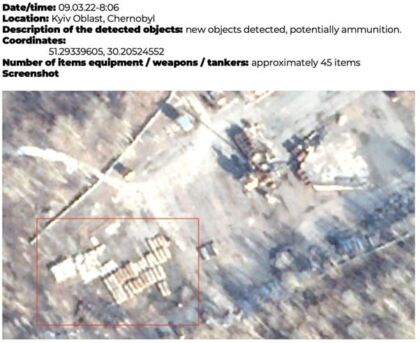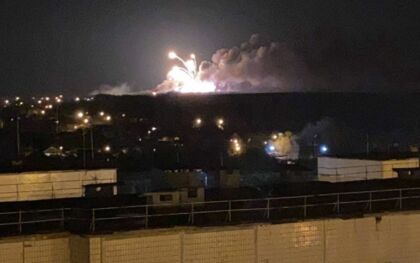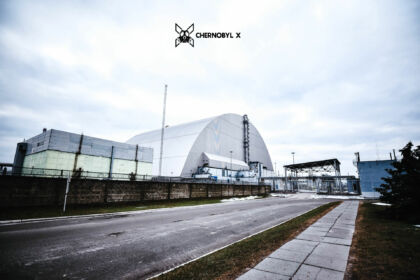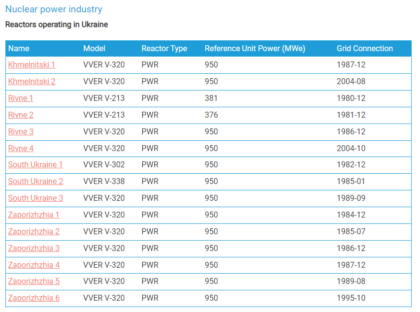With Russian forces occupying the Zaporizhzhya Nuclear Power Plant – one of Ukraine’s four Nuclear Power Plants, as well as the site of the decommissioned Chernobyl facility, the world is getting an unprecedented look at the first major war to ever take place in a country with an established nuclear power system.
The Russian Federation has proved that it is not planning to abide by the rules of war established by international law. In addition to bombing residential areas and civilian infrastructure Russian troops have encroached upon international security and resorted to nuclear terrorism.
Fortunately, there had not been any acts of nuclear or radiological terrorism until February 24, 2022. On that day, a DAZV (State Agency of Ukraine on Exclusion Zone Management) representative reported that Russian troops had taken over the Chernobyl Nuclear Power Plant and the station’s staff as hostages.
What is Nuclear Terrorism?
IAEA defined „Nuclear terrorism“ as acts of violence and destruction where the means applied are nuclear devices, or threats of use of such means, to create a condition of fear, to get attention, or to blackmail to have wider effect on others than the directly targeted victim(s).
Nuclear terrorism is a subset of radiological terrorism, were the means (or threads) applied are radioactive substances. While being distinctly dissimilar in terms of technical approaches and damage potentials, many of the features with regards to public threat perception are likely to be similar.
Some definitions of nuclear terrorism include the sabotage of a nuclear facility and/or the detonation of a radiological device, colloquially termed a “dirty bomb”, but consensus is lacking.
In legal terms, nuclear terrorism is an offense committed if a person unlawfully and intentionally „uses in any way radioactive material … with the intent to cause death or serious bodily injury; or with the intent to cause substantial damage to property or to the environment; or with the intent to compel a natural or legal person, an international organization or a State to do or refrain from doing an act“, according to the 2005 United Nations International Convention for the Suppression of Acts of Nuclear Terrorism.
Nuclear Power in Ukraine
Nuclear energy development in Ukraine started in 1970 with construction of the Chernobyl power plant – the first unit being commissioned in 1977. Unit 4 came online in 1983 and was destroyed in 1986.
Though the Ukrainian nuclear industry was closely involved with Russia for many years, it remained relatively stable during the changes that occurred when the country became independent from the former Soviet Union.
Nowadays, Ukraine runs 15 nuclear reactors accounting for about half of its electricity generation, according to the World Nuclear Association. All reactors are Russian VVER types, two being upgraded 440 MWe V-312 models and the rest the larger 1000 MWe units – two early models and the rest V-320s. But seven of these reactors have been disconnected from the grid since Russian attacks began on February 24 in order to keep them cool.
As of 21 March, eight of the country’s 15 reactors were operating: two at Zaporizhzhya (units 2&4), three at Rivne (units 2-4), one at Khmelnitsky (unit 1), and two at South Ukraine (units 1 and 2).
In fact, during that period and since, there have been continuing improvements in the operational safety and output levels of Ukraine’s nuclear reactors. Load factors increased steadily since the first reactor was commissioned in 1977 and reached 81.4% in 2004. A decrease of the country’s load factor after 2005 is related to restrictions imposed by the national electricity grid. In 2019, it was 75%. At the end of 1995, Zaporozhya 6 was connected to the grid making Zaporozhya the largest nuclear power station in Europe, with a net capacity of 5700 MWe. (The second largest station operating is Gravelines, near Dunkerque in France, with a net capacity of 5460 MWe.)
Russian Occupation of the Chernobyl Zone
On 24 February Russia started a war against Ukraine. On that very day, Ukraine informed the IAEA that Russian forces had taken control of all facilities of the Chernobyl Nuclear Power Plant.
 24.02.2022, 06:26 Abandoned checkpoint „Dytyatky“. The last photo before the capture of the Chernobyl Zone by Russian soldiers.
24.02.2022, 06:26 Abandoned checkpoint „Dytyatky“. The last photo before the capture of the Chernobyl Zone by Russian soldiers.Photo: Oleksandr Syrota
On February 24, 2022, at about 5 pm, all facilities of the Chernobyl NPP located in the Exclusion Zone: nuclear fuel storage facilities, the New Safe Confinement for Shelter; Units 1, 2, 3 of the Chernobyl NPP at the stage of decommissioning – were taken under the control of Russian invaders. The servicemen of the Ukrainian military unit guarding the Chernobyl NPP were disarmed.
“After the absolutely senseless attack of the Russians in this direction, it is impossible to say that the Chernobyl Nuclear Power Plant is safe,” – told Myhailo Podolyak, an adviser to Ukrainian President Volodymyr Zelensky.
As the representative of the Ukrainian authorities at this facility, and the head of the Chernobyl NPP shift, Valentyn Heiko was able to ensure a mode of operation in which the military unit that captured the station would not interfere in the work of the specialists.
In addition to the station’s operational staff, servicemen of the National Guard of Ukraine, firefighters of the State Emergency Service, and medical staff of the Chernobyl health center at the Slavutych City Hospital were held hostage.
 The checkpoint “Dytyatky” in the first days of the Russian invasion- an entrance to the Chernobyl Exclusion Zone.
The checkpoint “Dytyatky” in the first days of the Russian invasion- an entrance to the Chernobyl Exclusion Zone.Photo: Unknown
For obvious information – Volodymyr Putin issued an order to prepare a terrorist attack at the Chernobyl Nuclear Power Plant to threaten the whole world with a nuclear disaster.
According to Ukraine’s Ministry of Defense: “Under the control of the Russian military ChNPP, it is planned to create a man-made disaster, but they will try to transfer it to Ukraine for the sake of occupation”.
At the time of the ChNPP, it is fully included in the monitoring systems of the International Atomic Energy Agency (IAEA). The ChNPP has been alarmed. The resource of the latest diesel generators for 48 hours insurance of robotic security system maintenance.
March 5
The SNRIU reported to the IAEA that staff at the Chernobyl Nuclear Plant have been onsite since 23 February without being able to rotate shifts for either technical personnel or guards.
March 9
The Chernobyl Nuclear Plant was disconnected from the electricity grid. The IAEA stated that it did not see a critical impact on safety as a result. After this, emergency diesel generators are turned on at the site to provide power to systems important to the safety of the facilities, including nuclear fuel storage facilities, as well as the New Safe Confinement of the Shelter facility. The stock of diesel fuel for the operation of the diesel generators is designed for 48 hours from the moment of losing the external power supply.
IMPORTANT: In case of the complete absence of energy, the personnel of the nuclear facilities of SSE „Chernobyl NPP“ lose the ability to control the safety parameters of enterprises, radiation status in spent nuclear fuel storage facilities, water level in the holding pool and its temperature, continuing the cleaning of the water holding pool, and also fire alarms. Also, in case of the loss of efficiency of the ventilation system and impossibility to implement compensatory measures, explosive concentrations of hydrogen may be formed due to the radiolysis reaction.
March 13
On 13 March, Energoatom reported that the transmission system operator, Ukrenergo had at 18.38 succeeded in repairing a power line needed to restore the external electricity supplies to Chernobyl.
March 14
At 16.45 local time the Chernobyl Nuclear Plant was reconnected to the national grid.
March 18
The Russian occupiers did not touch the people, but robbed all the offices of the enterprises located in the town of Chernobyl.
They took computer system units, office equipment, and workers’ uniforms. The remaining vehicles on the territory of the enterprises were destroyed, or robbed by Russian soldiers.
There is no light in Chernobyl. In total, about 300 people remained in Chernobyl town.
March 20
The SNRIU confirmed that around half of the staff at the Chernobyl nuclear plant, who were there for about 600 hours, had been able to rotate and return to their homes for the first time since 23 February.
64 people were safely evacuated from the Chernobyl Zone:
- 50 employees of ChNPP;
- 9 members of the National Guard of Ukraine (8 women and one cancer patient);
- 1 servicewoman from the National Emergency Service;
- 4 “Stalkers” (illegal visitors)
Despite all the fear and terror, that 🇷🇺 invaders brought, 46 people (professionals) volunteered to replace the evacuated personnel of the Chernobyl NPP to perform their duties and to ensure the functioning of the enterprise.
March 23
The personnel who were brought back from the seized Chernobyl Nuclear Power Plant met with the Power Plant’s management and the Mayor of the satellite town Slavutych.
The main goal of the meeting was to provide ChNPP employees (who were cut off from their community for nearly a month) with the latest information about the town and the rest of Ukraine.
The ChNPP Acting Director General spoke about the NPP’s operation, salaries and social problems that will be solved by the Enterprise. Slavutych Mayor spoke about the situation in the town and the latest news about it.
After the briefing, a Q&A session was held where the ChNPP management and town administration answered all the questions asked by the rotated workers.
March 31
The Russian side agreed to officially return to Ukraine responsibility for control over the Chernobyl nuclear power plant.
The International Atomic Energy Agency (IAEA) has said it is preparing to send its mission to Chernobyl.
April 1
“All technological equipment of the Chernobyl nuclear power plant works, in particular, the control and monitoring systems for radiation indicators”.
This was reported by the press service of „Energoatom“ with reference to the words of the director of the Chernobyl Nuclear Power Plant Valery Seyda.
It is noted that now there is not a single Russian military on the territory of the Chernobyl NPP: they left the station on March 31 before 20:00 (Kyiv time), taking with them the National Guardsmen, who had been held as hostages since the capture of the Chernobyl facility.
„We cannot yet estimate the total losses. The occupiers took with them five of the 15 containers with equipment for repairs and spare parts necessary for the Chernobyl Power Plant. We cannot yet say what exactly was there,“ – said the director of the Chernobyl Nuclear Power Plant.
The Nuclear Power Plant is operating as usual. This applies to both the Shelter facility and spent fuel storage facilities.
 Ukrainian flag raised in front of the main entrance of the Chernobyl NPP.
Ukrainian flag raised in front of the main entrance of the Chernobyl NPP.Photo: DAZV
The flag of Ukraine was raised again at the Chernobyl industrial site. According to the State Specialized Enterprise „Chernobyl NPP“, the anthem of Ukraine was played during the raising of the flag.
April 3
 In the photo the Ukrainian military holding the Ukrainian flag in front of the New Safe Confinement.
In the photo the Ukrainian military holding the Ukrainian flag in front of the New Safe Confinement.Photo: Unknown
The day when Ukrainian militaries took control of the city of Pripyat and the area of the Ukrainian border with Belarus.
Why Russian troops captured the Chernobyl Nuclear Power Plant

Why should Russia seize a nuclear power plant that is not working and is also surrounded by kilometers of contaminated territory?
The answer probably lies in its geographical location.
„This is the shortest way from point A to point B,“ said Carnegie Endowment expert James Acton.
Former United States Chief of Staff, Jack Keane agrees, saying Chernobyl „has no military significance“ but is on the shortest route from Belarus to Kyiv.
Keane calls this path one of the four directions in which the Russian army is advancing, noting that it is the most massive invasion in Europe since World War II. In fact, Chernobyl is located only 130 kilometers north of Kyiv and may be a convenient destination for an attack on the Ukrainian capital.
According to Samantha Turner of the Truman National Security Project (a Washington-based national security organization), control of the area does not bode well for success in the military operation, but gives Russian troops an important corridor leading to the Dnipro river.
„For them, it’s an important part of opening different corridors to advance troops and control key areas,“ Turner said.
According to the Council, since the Russian invasion of the area, many radiological observation posts have recorded excess gamma radiation, and radioactive dust could rise into the air from the movement of heavy equipment.
Chernobyl NPP as a Russian Military Base
The National Security and Defense Council of Ukraine published satellite images, which clearly show the movement of a large convoy of Russian military trucks with ammunition a few hundred meters from the Chernobyl Nuclear Power Plant and places of unloading munitions in the settlement of Chernobyl, where they are stored in the open air.

The use of the Chernobyl Zone for the transportation and accumulation of ammunition, as well as the deployment of command posts of Russian troops is carried out deliberately, as the Armed Forces of Ukraine can not fight in the Exclusion Zone.

The risk of detonation of Russian ammunition is high and without hostilities, due to the occupiers‘ neglect of security measures, as well as the widespread use of old and substandard ammunition.
Such an incident occurred on March 29, in Russian Belgorod – due to neglect of safety rules and violation of the requirements for transportation of ammunition – unauthorized detonation took place. It’s 10 kilometers from the border with Ukraine.
 Moment of explosion at an ammunition depot in Belgorod
Moment of explosion at an ammunition depot in BelgorodPhoto: from social networks
The explosion at an ammunition depot in Belgorod is an example of the typical mass use of obsolete dangerous munitions by Russian servicemen, particularly during World War II.
The General Staff of the Armed Forces of Ukraine warns of the threat of self-detonation of ammunition, a huge number of which Russia has arranged in the area of the Chernobyl Nuclear Power Plant.
The Russian Federation and its numerous agents in international organizations deny the transportation and accumulation of huge amounts of ammunition by Russian troops in the immediate vicinity of the Chernobyl isolation facilities, which could at any time lead to unauthorized detonation of ammunition, damage to New Safe Confinement (Shelter), damage to radiation contamination in the areas with hundreds of millions of Europeans.
600 hours at the occupied Chernobyl NPP

One of the Chernobyl workers, who returned from the captured station, said what happened there during almost a month of occupation:
On 24th of February, a column of tanks arrived at the Chernobyl Nuclear Power Plant from the Pripyat side, approached one of the station buildings and aimed their barrels at the building. The Russians threatened to „turn everyone into meat.“ And this despite the fact that on the territory of the nuclear facility can not fight. The commander of the National Guard ordered to lay down his arms”.
Russian occupiers set up a barrack for our military in the administrative building, during the day they were gathered in the assembly hall. Movement was restricted on some floors, where the occupiers stationed their personnel. They increased in number every day.
Radiation Hazard

Control Room 4
Photo: ChernobylX
Radiation hazard was a stimulus for the occupiers. We tried to scare them with this. After all, they themselves did not understand where they are.
When we told them that there was radiation around, they made big eyes, they were scared. They did not have dosimeters with them.
They even asked how to “remove” radiation. I advised them not to accumulate it. And when they asked how to do it, I replied: „Get out of here and go home, then you will be safe.“
At first I tried to communicate with them because I wanted to understand how these people could start this war. But it turned out that they were just “zombies”. They really believed that they brought us peace and liberation.
We Slept Where We Worked – On The Floor

Workers at the Chernobyl NPP before Russian invasion
Photo: ChernobylX
I did not have a bed. Where we worked, there we slept, on the floor. We still had a radio as a means of communication, we constantly listened to what was happening in Ukraine. There was no mobile connection or internet.
Some of the staff did not allow Russians to visit their working places, but my coworker and I were almost constantly under surveillance and could not even speak in such a way that the occupiers did not hear.
We were not deprived of food. The occupiers ate separately, they had their own products. We have a canteen at the station that feeds the staff. There were enough food supplies in the warehouses for about a month. But the bread ran out on the third day.
In addition, we had a medical center and two paramedics. There was little medicine, but the medics helped the staff as best they could.
The cook was so exhausted that she needed medical help. About three hundred people had to be fed, and there was only one cook at the station. And at some point she was so exhausted that she had to be put on a drip.
Russians pretended to be Chernobyl workers

Chernobyl NPP before the invasion
Photo: ChernobylX
Russian occupiers decided to film a fake story about how they were distributing humanitarian aid to the NPP’s staff, then our leadership immediately warned us not to take part in it.
Then the occupiers got Novarka company overalls – an enterprise that built a cover over the fourth power unit and has not been working in our country for a long time. The Russians got dressed and pretended to be Chernobyl workers.
Later, the occupiers brought their specialists from Rosatom to the station. When I saw them, civilians, I decided to ask if they were really nuclear specialists.
They really understood where they were and how serious our object is. They knew that spent nuclear fuel is stored here.
But when I asked them if they knew that their soldiers fired from tanks at the Zaporizhzhya NPP, they just smiled and said, „It can’t be.“ Then I couldn’t stand it and just scolded them. They turned out to be the same zombies living in parallel reality.
Russia as Nuclear Terrorist
Chernobyl is not the only station captured by the Russians. One week after the Chernobyl occupation, Russian troops damaged Zaporizhzhya, Europe’s largest nuclear power plant, and planted mines around the site.
Several Ukrainian organizations have immediately appealed to the International Atomic Energy Agency (IAEA) to close the airspace over Ukraine’s nuclear facilities, as this is the first time in human history that troops have deliberately shelled a nuclear power plant.
 The New Safe Confinement, the Chernobyl Exclusion Zone
The New Safe Confinement, the Chernobyl Exclusion ZonePhoto: ChernobylX
The fact of seizure of the world-famous Chernobyl Nuclear Power Plant has all the hallmarks of an act of nuclear terrorism committed against Chernobyl nuclear facilities and its personnel by military units of the Russian Federation. This is a field for blackmail from the Russian side, so it can be manipulated in case of adverse events.
Experts emphasize that the lack of catastrophic consequences of the Russians‘ actions at the Chernobyl NPP is the merit of a team of captured power engineers. Ukraine has not yet received international assistance.
In order to imitate the accountability of the Ukrainian military before the accident at the Chernobyl NPP, the occupiers try to create fake „proofs“ to confirm their version. In particular, in the area of Antonov airport near Gostomel, Russian automobile refrigerators were marked, as they picked up the bodies of dead Ukrainian defenders. There is a possibility that they will be presented as killed saboteurs in the Chernobyl Zone.
So, without taking into account the important result of the ground military operation and direct negotiations, Putin is ready to go into nuclear blackmail of the light of the world for the sake of an act of support for Ukraine.
Nevertheless, such actions by Putin will have catastrophic consequences for the whole world. It seems that this is what the Russian dictator is counting on, demanding unacceptable concessions.
 Russians tanks in front of the Chernobyl Nuclear Power Plant.
Russians tanks in front of the Chernobyl Nuclear Power Plant.Photo: Unknown
About a thousand Russian troops and 50 units of equipment were on the territory of the Chernobyl Nuclear Power Plant, in the city of Chernobyl – up to 500 soldiers.
This was stated by Chairman of the State Agency of Ukraine for Exclusion Zone Management Yevhen Kramarenko at a briefing at Ukraine Media Center.
According to him, about 10,000 units of Russian equipment passed through Chernobyl as they left the occupied part of Kyiv Region. All this equipment could be exposed to radiation pollution, and Russian soldiers could receive radiation.



 ChernobylX
ChernobylX
 ChernobylX
ChernobylX 

